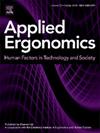The benefits of automation transparency are dependent on human attention control capacity
IF 3.4
2区 工程技术
Q2 ENGINEERING, INDUSTRIAL
引用次数: 0
Abstract
Increasing automation transparency can improve human decision-making by facilitating appropriate reliance on automated advice. Individual differences in human information processing capacity, or attention control capacity (ACC), may determine how effectively transparency information can be processed and used. We examined the extent to which ACC moderates the relationship between increased transparency provision and accuracy of automation use. Participants completed a simulated uninhabited vehicle (UV) task and were provided automated advice regarding which UV to select to complete missions, accompanied by either no, medium, or high automation transparency. Participants with higher ACC benefitted more from the provision of increased transparency. Specifically, transparency increased the accuracy of automation use for participants with higher ACC, but did not benefit participants with lower ACC. These findings indicate that human ability to effectively process and use transparency information may be dependent on their ACC, which may have implications for interface design, and operator selection and training.
自动化透明度的好处取决于人的注意力控制能力
增加自动化的透明度可以通过促进对自动化建议的适当依赖来改进人类的决策。人类信息处理能力或注意控制能力(ACC)的个体差异可能决定了透明信息的处理和使用效率。我们检查了ACC调节增加透明度提供和自动化使用准确性之间关系的程度。参与者完成了一个模拟的无人车(UV)任务,并提供了关于选择哪个无人车来完成任务的自动建议,同时伴有无、中等或高度自动化透明度。行政协调会较高的参与者从提高透明度中获益更多。具体而言,透明度提高了ACC较高的参与者使用自动化的准确性,但对ACC较低的参与者没有好处。这些发现表明,人类有效处理和使用透明信息的能力可能取决于他们的ACC,这可能对界面设计、操作员选择和培训产生影响。
本文章由计算机程序翻译,如有差异,请以英文原文为准。
求助全文
约1分钟内获得全文
求助全文
来源期刊

Applied Ergonomics
工程技术-工程:工业
CiteScore
7.50
自引率
9.40%
发文量
248
审稿时长
53 days
期刊介绍:
Applied Ergonomics is aimed at ergonomists and all those interested in applying ergonomics/human factors in the design, planning and management of technical and social systems at work or leisure. Readership is truly international with subscribers in over 50 countries. Professionals for whom Applied Ergonomics is of interest include: ergonomists, designers, industrial engineers, health and safety specialists, systems engineers, design engineers, organizational psychologists, occupational health specialists and human-computer interaction specialists.
 求助内容:
求助内容: 应助结果提醒方式:
应助结果提醒方式:


